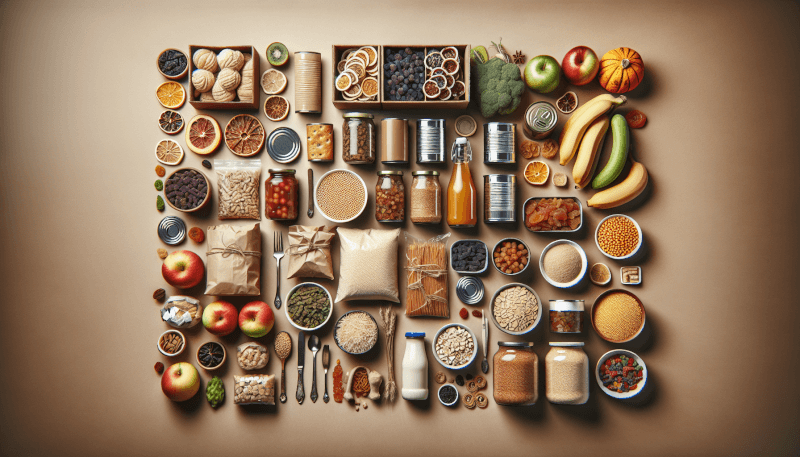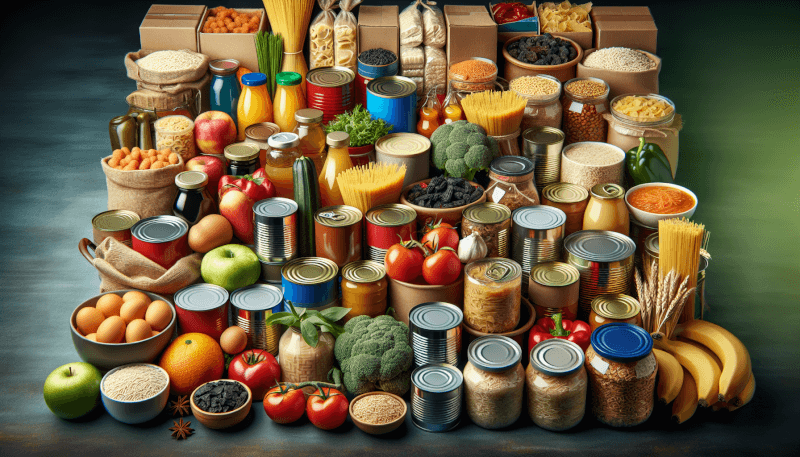Have you ever wondered what you would do if a natural disaster or sudden crisis struck and left you without access to food? It’s a scenario nobody wants to think about, but being prepared is essential. In “Emergency Food Storage: What You Need To Know”, this article will provide you with valuable insights and tips on how to create a reliable emergency food supply. From the best types of food to store, to proper storage methods and rotation techniques, you will gain the knowledge necessary to ensure the wellbeing of yourself and your loved ones in the face of an unforeseen emergency.

Why is Emergency Food Storage Important?
Preparing for Natural Disasters
Having an emergency food storage is crucial when it comes to preparing for natural disasters. When a disaster strikes, such as a hurricane, tornado, or earthquake, the availability of food may become limited or even non-existent for a period of time. By having a well-stocked emergency food storage, you can ensure that you and your loved ones have access to nutritious meals even when grocery stores are unable to restock their shelves. This can provide much-needed peace of mind during challenging times.
Surviving a Financial Crisis
In addition to natural disasters, emergency food storage can also be a lifesaver during a financial crisis. Unforeseen circumstances, such as job loss or a sudden decrease in income, can leave individuals and families struggling to put food on the table. An emergency food storage can serve as a safety net, providing the essential sustenance you need to weather financial hardships until you can get back on your feet. It is a proactive measure that can help alleviate stress and ensure that you and your family have the nourishment necessary to stay healthy.
Ensuring Food Security
One of the primary benefits of emergency food storage is its ability to ensure food security. Having an ample supply of non-perishable food items gives you the assurance that you will not go hungry during unexpected events or emergencies. Whether it’s a natural disaster, a financial crisis, or any other situation that disrupts the normal availability of food, having a well-prepared emergency food storage can provide the peace of mind knowing that you and your loved ones will have access to essential nutrients to maintain your health.
Coping with Power Outages
Power outages can occur for various reasons, such as severe storms or infrastructure issues. During these times, refrigerators and freezers may be rendered useless, putting perishable food at risk of spoiling. Having an emergency food storage that consists of non-perishable items like canned goods, dehydrated foods, and freeze-dried meals allows you to have access to nutritious meals even without electricity. It can be particularly useful in situations where power outages are prolonged, ensuring that you have sustenance until power is restored.
Types of Emergency Food Storage
Canned Goods
Canned goods are a staple of emergency food storage. They have a long shelf life and are available in a wide variety of options, from fruits and vegetables to meats and soups. The canning process helps preserve the food inside, ensuring that it remains safe and edible for an extended period. Canned goods are easy to store, require no additional preparation, and can be consumed straight from the can if necessary. It is important to rotate canned goods in your storage periodically to maintain their quality.
Dehydrated Foods
Dehydrated foods are another popular option for emergency food storage. The dehydration process removes the moisture from the food, which helps prevent spoilage and allows for long-term storage. Dehydrated foods can include items like dried fruits, vegetables, and even complete meals. These foods are lightweight, compact, and often have a lengthy shelf life. To rehydrate dehydrated foods, simply add water, making them a convenient choice when cooking facilities or resources may be limited.
Freeze-Dried Meals
Freeze-dried meals are a more advanced form of food preservation. By freeze-drying, the moisture is removed from the food while preserving its taste, texture, and nutritional value. Freeze-dried meals are known for their long shelf life, often lasting for decades if stored properly. They are lightweight and easy to prepare, typically requiring only the addition of hot water. With a wide variety of freeze-dried meal options available, you can enjoy familiar and delicious meals even during emergencies.
MREs (Meals Ready to Eat)
MREs, or Meals Ready to Eat, are pre-packaged meals that are specifically designed for military personnel. These meals are self-contained and require no additional preparation. They are designed to be portable, lightweight, and provide the necessary nutrients for sustenance in challenging environments. MREs have a long shelf life and are a convenient option for emergency food storage. While they may not be as readily available to the general public as other options, they are still worth considering for your emergency food supply.
Dry Goods
Dry goods, such as rice, beans, pasta, and grains, are essential when it comes to emergency food storage. They are inexpensive, have a long shelf life when properly stored, and provide a good source of carbohydrates and essential nutrients. Dry goods can be easily incorporated into a variety of recipes and can serve as a foundation for well-balanced meals. It is important to store dry goods in airtight containers to prevent spoilage and to keep them in a cool, dry place.

Factors to Consider When Building Your Emergency Food Storage
Caloric and Nutritional Requirements
When building your emergency food storage, it is crucial to consider your caloric and nutritional requirements. The number of calories you need per day will depend on factors such as age, sex, and activity level. Aim to maintain a well-balanced diet by including a variety of food items that provide essential nutrients like protein, carbohydrates, fats, vitamins, and minerals. Having a diverse selection of foods ensures that you and your family receive the necessary nutrients during an emergency.
Storage Space and Shelf Life
Another important factor to consider is the amount of storage space available to you and the shelf life of the food items. If you have limited storage space, consider compact and lightweight options like freeze-dried meals or dehydrated foods. It is also essential to check the expiration dates on food items and rotate them regularly to maintain their freshness. Be mindful of the shelf life of each product and plan accordingly to ensure that your emergency food storage remains viable.
Personal Preferences and Diet Restrictions
Personal preferences and any dietary restrictions should also be taken into account when building your emergency food storage. Consider the tastes and preferences of everyone in your household, as well as any specific dietary restrictions or allergies. Look for options that cater to these preferences and restrictions, ensuring that everyone can still enjoy nutritious meals during an emergency situation. There is a wide range of emergency food storage options available that cater to specific dietary needs.
Availability and Sourcing
Consider the availability and sourcing of the food items you choose for your emergency storage. While it may be tempting to rely solely on purchasing already prepared emergency food kits, it is also important to diversify your sources. Look for local farmers’ markets, bulk food suppliers, or online retailers that offer a variety of non-perishable food items. This can help ensure availability and provide you with a more cost-effective way of building your emergency food storage.
Budget Considerations
Lastly, consider your budget when building your emergency food storage. While the initial investment may seem significant, keep in mind that emergency food storage is a long-term investment in your well-being and peace of mind. Look for sales, discounts, and bulk purchasing options to help stretch your budget. Consider adding to your food storage gradually over time to make it more financially manageable. Remember, having even a small emergency food supply is better than having no supply at all.
How to Store Emergency Food Properly
Choosing the Right Containers
Choosing the right containers for your emergency food storage is essential to ensure the longevity and safety of the food items. Opt for airtight and moisture-proof containers that will keep out pests, moisture, and oxygen. Mason jars, food-grade buckets with tight-fitting lids, and vacuum-sealed bags are all good options for long-term storage. Be sure to label each container with the contents and expiration date to facilitate easy inventory management.
Creating a Rotation System
To maintain the freshness and quality of your emergency food storage, it is important to create a rotation system. This ensures that older items are used first, reducing the risk of spoilage or waste. Implement a “first in, first out” system by placing newly purchased items at the back of your storage area and moving older items to the front. Regularly check the expiration dates of your food items and replace any that are nearing their expiration to ensure your emergency food storage remains viable.
Optimal Storage Conditions
To ensure optimal storage conditions for your emergency food, it is crucial to keep your storage area cool, dry, and away from direct sunlight. Temperature fluctuations can negatively affect the quality and shelf life of food items. Aim for a stable temperature between 50°F and 70°F (10°C to 21°C). Avoid storing your emergency food in areas prone to high humidity, such as basements or attics. Moisture can lead to mold or spoilage. Keep the area clean and organized to prevent pest infestation.
Protection from Pests and Spoilage
Protecting your emergency food storage from pests and spoilage is paramount. Pests like rodents, insects, and even pets can be attracted to stored food. Ensure all containers are well-sealed and free from any holes or cracks. Consider using pest-resistant containers or adding pest deterrents, such as bay leaves or diatomaceous earth, to your storage area. Regularly inspect your food storage for signs of pests or spoilage, and take appropriate action if necessary.

Planning and Maintaining Your Emergency Food Storage
Determining Your Needs
Before building your emergency food storage, it is important to determine your specific needs. Consider factors such as the number of people in your household, any special dietary needs or medical conditions, and the potential duration of a crisis situation. Take into account the amount of food required per person per day and multiply it by the number of days you want your emergency food storage to last. This will help you gauge the quantity of food you need to purchase and store.
Creating a Long-Term Food Storage Plan
Creating a long-term food storage plan will help ensure that your emergency food storage remains viable and well-maintained. Start by setting a realistic goal for the quantity of food you want to store. Divide your goal into smaller, achievable milestones, and work towards them gradually. Regularly review and update your plan, taking into account changes in household size, dietary restrictions, or expiration dates. Document your plan and keep it easily accessible for reference.
Regularly Checking and Restocking
Regularly checking and restocking your emergency food storage is an important part of maintenance. It is recommended to check your supplies at least once every six months. Assess the condition of each food item, checking for any signs of spoilage or damage. Replace any expired or compromised items promptly. Take note of any changes in your household’s needs or preferences and adjust your storage plan accordingly. Regularly reviewing and restocking your emergency food storage ensures its effectiveness and keeps it up-to-date.
Considering Family and Special Needs
When planning and maintaining your emergency food storage, it is important to consider the unique needs of your family members. Take into account any special dietary requirements, allergies, or food restrictions. Make sure to have appropriate options available for each individual, ensuring that everyone has access to suitable and nourishing meals. In addition, consider the needs of infants, elderly family members, or individuals with medical conditions that may require specific nutritional requirements or additional food items.
Supplementing Your Emergency Food Storage
Growing Your Own Food
A great way to supplement your emergency food storage is by growing your own food. Planting a vegetable garden or setting up a small herb garden can provide you with fresh, nutritious produce during an emergency. Consider growing fruits and vegetables that are easy to maintain and have a high yield, such as tomatoes, peppers, lettuce, and herbs like basil or parsley. Remember to store seeds for future planting and educate yourself on gardening techniques that can maximize your harvest.
Livestock and Poultry
For those with more space and resources, raising livestock and poultry can be an effective way to supplement your emergency food storage. Chickens, rabbits, and goats are popular choices for backyard farming. They can provide a sustainable source of meat, eggs, and milk if properly cared for. Before embarking on raising livestock, ensure that you have the necessary knowledge, space, and resources to support them, as it can require additional time and effort.
Foraging for Wild Edibles
Foraging for wild edibles can be a valuable skill during an emergency. Learn about edible plants and mushrooms that are native to your region and safe for consumption. Take classes or consult guidebooks to familiarize yourself with the identification and preparation of these wild edibles. Remember to respect the environment, harvest responsibly, and only forage from areas that are free from contamination or pollutants.
Hunting and Fishing
If you have the knowledge and resources, hunting and fishing can also provide an additional food source during an emergency. Be sure to follow all local laws and regulations regarding hunting and fishing. Learn proper hunting and fishing techniques, as well as food preparation and preservation methods. Hunting and fishing should be seen as a supplement to your emergency food storage, not a sole reliance, as success is not guaranteed and may be subject to local restrictions or environmental conditions.

Using and Preparing Emergency Food Storage
Meal Planning and Recipes
Effective use of your emergency food storage involves meal planning and recipe preparation. In times of crisis, it is important to make the most of the resources available to you. Take inventory of your food items and plan meals that utilize those ingredients. Look for recipes that require minimal additional ingredients or cooking resources. Consider developing a meal plan that incorporates a variety of flavors and nutrients to keep meals interesting and satisfying.
Food Preparation Methods
During an emergency, access to traditional cooking methods may be limited. Familiarize yourself with alternative food preparation methods that can be used with your emergency food storage. For example, invest in a camping stove or a portable cook set that utilizes minimal fuel. Learn how to use a solar cooker or create a makeshift oven using basic household items. Remember to practice these alternative cooking methods before an emergency situation arises to ensure efficiency and safety.
Water Storage and Purification
Proper water storage and purification are equally important aspects of emergency preparedness. In addition to having ample food supplies, ensure that you also have an adequate supply of clean water. Store water in food-grade containers that are tightly sealed and keep them in a cool, dark place. It is also essential to have water-purification methods or supplies on hand, such as water filters or water purification tablets. Research and educate yourself on different methods of water purification to ensure a safe water supply during emergencies.
Emergency Food Storage Myths and Misconceptions
Expiration Dates and Shelf Life
One common myth regarding emergency food storage is the belief that all food items are no longer safe to consume once they reach their expiration dates. While it is important to take expiration dates into consideration, it is equally important to understand that many food items, when stored properly, remain safe and edible past their expiration dates. Familiarize yourself with the signs of spoilage and trust your judgment when deciding if a food item is still fit for consumption.
Relying Solely on Canned Foods
Another misconception is that relying solely on canned foods is sufficient for an emergency food storage plan. While canned goods are an important component, it is recommended to diversify your storage with a variety of food items. This ensures a well-balanced diet and provides a broader range of flavors and nutrients. Incorporate freeze-dried meals, dehydrated foods, and dry goods to create a more comprehensive emergency food storage supply.
Nutritional Quality and Variety
Some believe that emergency food storage lacks nutritional quality and variety. While it is true that processed and prepackaged foods often make up a significant portion of emergency food storage, there are options available that prioritize nutritional value. Look for products that offer a balance of macronutrients and essential vitamins and minerals. Additionally, supplement your emergency food storage with fresh produce, grown or foraged, to enhance the nutritional quality and variety of your meals.
Bulk Buying and Cost
Bulk buying is often associated with emergency food storage, leading to the assumption that it is expensive and beyond the financial means of many individuals. While buying in bulk can be cost-effective in the long run, it is not the only option for building an emergency food supply. Start small and gradually build your storage over time. Take advantage of sales, discounts, and coupons to stretch your budget. Remember, even a small emergency food storage is better than having none at all.

Emergency Food Storage for Special Dietary Needs
Vegetarian and Vegan Options
Individuals with vegetarian or vegan diets can still build an effective emergency food storage. Look for plant-based protein sources such as beans, lentils, quinoa, and textured vegetable protein. Canned vegetables and fruits can provide nutrients and variety. Additionally, consider freeze-dried vegetables and fruits, which offer convenience and a longer shelf life. Non-dairy milk alternatives and nut butters are also good options. Ensure that you have a sufficient supply of vitamins and minerals, either through supplements or fortified foods.
Gluten-Free and Allergen-Free
For those with gluten sensitivities or allergies, it is important to ensure that your emergency food storage is gluten-free. Look for gluten-free grains like rice, quinoa, and gluten-free pasta. Check food labels for potential allergens and cross-contamination warnings. There are also specialty companies that offer gluten-free emergency food kits. Take note of any other allergens present in your household and ensure they are also accounted for when building your emergency food storage.
Medical Conditions and Restrictions
Individuals with specific medical conditions may have additional dietary restrictions that need to be considered when building an emergency food storage. Consult with healthcare professionals, such as dietitians or doctors, to understand the specific dietary requirements for your condition. They can provide guidance on suitable food choices and any additional supplements that may be necessary. It is crucial to ensure that your emergency food storage can adequately support your medical needs during a crisis.
Conclusion
Emergency food storage is an essential part of preparedness for a variety of situations. Whether it be natural disasters, financial crises, or ensuring food security, having a well-stocked emergency food supply provides peace of mind and the assurance that you and your loved ones will have access to nourishing meals during challenging times. By carefully considering factors such as caloric needs, storage space, personal preferences, and budget, you can build an effective and sustainable emergency food storage. Remember to regularly maintain, rotate, and supplement your supply to ensure its effectiveness and to adapt to the changing needs of your household. With proper planning and preparation, emergency food storage can provide comfort and security in uncertain times.


